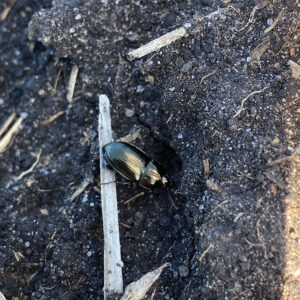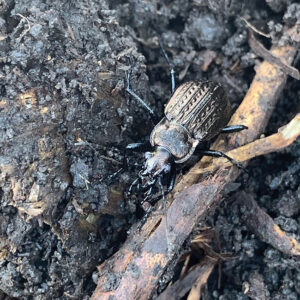
Features
Pests
The guts of the matter
Which crop pests are ground beetles and spiders eating in Alberta fields?
May 31, 2023 By Carolyn King
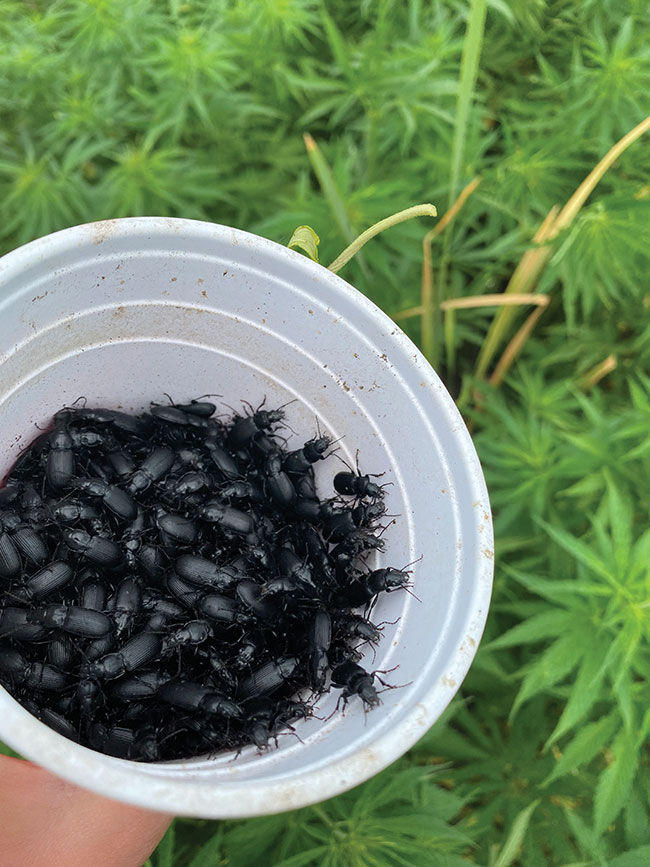 This research uses pitfall traps to collect samples of ground-dwelling predators in order to find out what pests these predators are eating.
This research uses pitfall traps to collect samples of ground-dwelling predators in order to find out what pests these predators are eating. Entomologist Boyd Mori’s research to analyze the gut contents of ground beetles and spiders might sound a bit esoteric. But it is in fact a key step toward figuring out how to maximize the pest control services these generalist predators can provide in our crop fields.
“A lot of research has been done to show that natural enemies, or predators, within our crop fields could be contributing to pest control. But there’s been limited work showing that these predators are actually having an effect on our pest species,” explains Mori, who holds the Natural Sciences and Engineering Research Council of Canada (NSERC) industrial research chair in agricultural entomology at the University of Alberta. “We want to make that connection between these predators and their actual impact on pest species in our fields.
“Some previous natural enemy studies have taken a single species approach, looking at a potential predator and a single pest species, and generally in a specific crop. We’re taking a broader approach. We’re looking at the complex community of pests and other insects that some generalist predators, like ground beetles and spiders, could be eating in different Alberta crops.”
Depending on the predator, these generalists could be consuming a lot of different things, such as various species of insects and other arthropods, earthworms, slugs, snails and seeds.
“Ultimately, we would like to show which predators are consuming which pests, and what impact that could have in our crop fields,” says Mori. “If we could determine that a specific ground beetle species or a specific spider species is really helping to manage our pests, then we could design conservation strategies to enhance those predator populations within our fields and try to get a better ‘bang for our buck’ with those predators.”
Predators, pests and others
This research encompasses four projects about ground-dwelling predators, led by Mori’s graduate students: ground beetles in wheat and hemp, led by Natalie LaForest; ground beetles in canola, led by Aldo Rios Martinez; spiders in canola, led by Kirra Kent; and ground beetles in peas and faba beans, led by Maggie MacDonald.
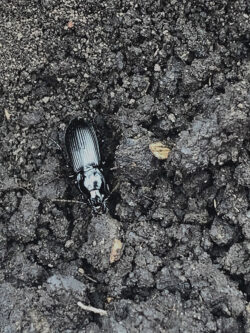
Pterostichus melanarius is by far the most common ground beetle species in the sampled crop fields.
Photo courtesy of Natalie LaForest, University of Alberta.
Over the last two years, the research team has collected samples of these predators and the rest of the insect community in canola, wheat, hemp, pea and faba bean fields in central Alberta. They hope to expand their sampling to other parts of Alberta in the future.
To collect the ground-dwelling predators, the team uses pitfall traps. Mori says, “Pitfall traps are basically cups that are buried in the ground so the opening of the cup is level with the soil surface. As ground-dwelling insects walk along, they fall into the cups.”
In 2021 and 2022, the team used these traps in weekly sampling throughout the summer to determine the different predator species and their abundance.
Their weekly sampling also included using yellow sticky cards and sweep nets to find out what potential pests and other insects were present in the crop fields.
At each sampling site, they collected samples at two locations: just inside the crop next to the field edge, and 100 metres into the field. Mori explains, “We want to see if the semi-natural habitat in the field edges, with the different plant species there, influences which insects are in our samples.”
In addition, three times over the summer, the team collected live predators in the pitfall traps and brought them back to the lab for DNA analysis of their gut contents and for feeding experiments.
Unexpected bonanza
“The field sampling in 2021 and 2022 went well. Although in 2021, with the heat, we had astronomical numbers of insects,” says Mori. “Just processing all those samples to identify the insects present has taken quite a long time. We are still working on some of the 2021 samples, particularly the sweeps and yellow sticky card samples.
“For instance, Natalie LaForest counted over 120,000 Pterostichus melanarius in 2021. And that’s just one species of ground beetle. We have collected multiple species in all these different sampling techniques that we’re using.”
Fortunately, the team was able to recruit extra help. In total, about 22 people worked on identifying the collecting insects in 2021. Along with the four graduate students leading the projects, there were eight undergraduates assigned to those projects, and other graduate students who pitched in to help out.
DNA detection
“For the DNA analysis, we freeze the collected predator samples and extract DNA particularly from their gut contents,” Mori says. “Then we will sequence that DNA, and using some bioinformatic approaches, hopefully we will be able to identify what other species, including potential pest species, these predators have been consuming in the field.”
The team is taking two different approaches to the DNA analysis. One approach involves using specific DNA primers that identify the DNA of particular pest species of interest. (A DNA primer is a short piece of DNA that targets a unique portion of an organism’s genome).
“So, if we are interested in determining if a predator in a canola field is eating flea beetles, diamondback moths or bertha armyworms, we can use specific primers for identifying each of those pests,” says Mori. “We have to develop some of those specific primers. Others have been previously developed, and we’re just optimizing them for our use.”
Their second approach is called high-throughput sequencing. “For that, we use generic primers. With insects and other arthropods, we use primers that target a specific gene region called the mitochondrial COI gene,” Mori explains.
“The premise is that each species will hopefully have a unique sequence at that part of that gene. We call that the DNA barcode, just like the barcodes in your grocery store where each item has a unique barcode identifying that item. Using the generic primers with high-throughput sequencing will hopefully allow us to identify the multitude of species these predators have been eating.”
High-throughput sequencing that targets COI sequences has already been developed, and Mori’s team is optimizing this method for their needs in this research.
Coming next
In summer 2023, the team will be scaling down their fieldwork to targeted sampling of certain predators. They won’t be doing the season-long, weekly sampling of the whole arthropod community.
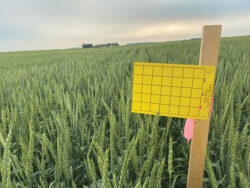
The sampling work also includes using yellow sticky cards to find out about the complex insect community in the fields.
Photo courtesy of Natalie LaForest, University of Alberta.
“We will be focusing our sampling particularly on the ground beetle Pterostichus melanarius and on ground-dwelling spiders, such as wolf spiders,” says Mori.
He adds, “Pterostichus melanarius is very dominant. As I mentioned, we had 120,000 beetles of that single species, while we had about 1,000 other beetles in our traps.”
Also in 2023, the team will continue their work to develop and optimize the DNA primers they need. In addition, they will be completing some experiments with live predators to see what these predators will eat in the lab and to find out how long each predator species takes to digest its gut contents. Mori says they need this digestion information to help ensure they are getting reliable results. “If we catch a beetle in the field and we don’t find anything in its gut, is that because it can digest its food very quickly or is there something wrong with our sampling, sequencing or other techniques?”
So, for example, if a particular ground beetle species eats three flea beetles, the team will be determining how many hours later flea beetle DNA will still be detectable in the DNA from the beetle’s guts.
Mori is hopeful this innovative research on generalist predators will help enhance the sustainability of Alberta crop production through integrated pest management.
“Our immediate goal is to figure out which predator species are the most effective at controlling pests in our field crops,” he says. “Then, the future step would be to figure out how we can promote these species within our fields for more ecologically-based pest management.”
Collaborators on this research include Maya Evenden at the University of Alberta, Christian Willenborg at the University of Saskatchewan, Carol Frost with the University of Alberta and Héctor Cárcamo with Agriculture and Agri-Food Canada.
Mori’s NSERC chair funding helps support this research, with sponsorship from the Alberta Canola Producers Commission, Alberta Wheat Commission, Alberta Barley Commission and Alberta Pulse Growers Commission. Some of the canola-focused work in this research is funded through the Canola Agronomic Research Program (CARP), which is administered by the Canola Council of Canada. This CARP research is supported through Alberta Canola and Western Grains Research Foundation. The Alberta Conservation Association is helping to fund the LaForest and Martinez projects.
